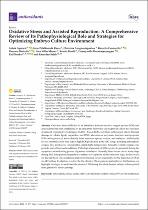Oxidative stress and assisted reproduction: A comprehensive review of its pathophysiological role and strategies for optimizing embryo culture environment
| dc.contributor.author | Agarwal, Ashok | |
| dc.contributor.author | Rosas, Israel Maldonado | |
| dc.contributor.author | Henkel, Ralf | |
| dc.date.accessioned | 2022-09-19T09:27:50Z | |
| dc.date.available | 2022-09-19T09:27:50Z | |
| dc.date.issued | 2022 | |
| dc.identifier.citation | Agarwal, A. et al. (2022). Oxidative stress and assisted reproduction: A comprehensive review of its pathophysiological role and strategies for optimizing embryo culture environment. Antioxidants, 11(3), 477. https://doi.org/10.3390/antiox11030477 | en_US |
| dc.identifier.issn | 2076-3921 | |
| dc.identifier.uri | https://doi.org/10.3390/antiox11030477 | |
| dc.identifier.uri | http://hdl.handle.net/10566/7910 | |
| dc.description.abstract | Oxidative stress (OS) due to an imbalance between reactive oxygen species (ROS) and antioxidants has been established as an important factor that can negatively affect the outcomes of assisted reproductive techniques (ARTs). Excess ROS exert their pathological effects through damage to cellular lipids, organelles, and DNA, alteration of enzymatic function, and apoptosis. ROS can be produced intracellularly, from immature sperm, oocytes, and embryos. Additionally, several external factors may induce high ROS production in the ART setup, including atmospheric oxygen, CO2 incubators, consumables, visible light, temperature, humidity, volatile organic compounds, and culture media additives. | en_US |
| dc.language.iso | en | en_US |
| dc.publisher | MDPI | en_US |
| dc.subject | Oxidative stress | en_US |
| dc.subject | Antioxidants | en_US |
| dc.subject | Culture media | en_US |
| dc.subject | Embryo development | en_US |
| dc.subject | Fertilization | en_US |
| dc.title | Oxidative stress and assisted reproduction: A comprehensive review of its pathophysiological role and strategies for optimizing embryo culture environment | en_US |
| dc.type | Article | en_US |

